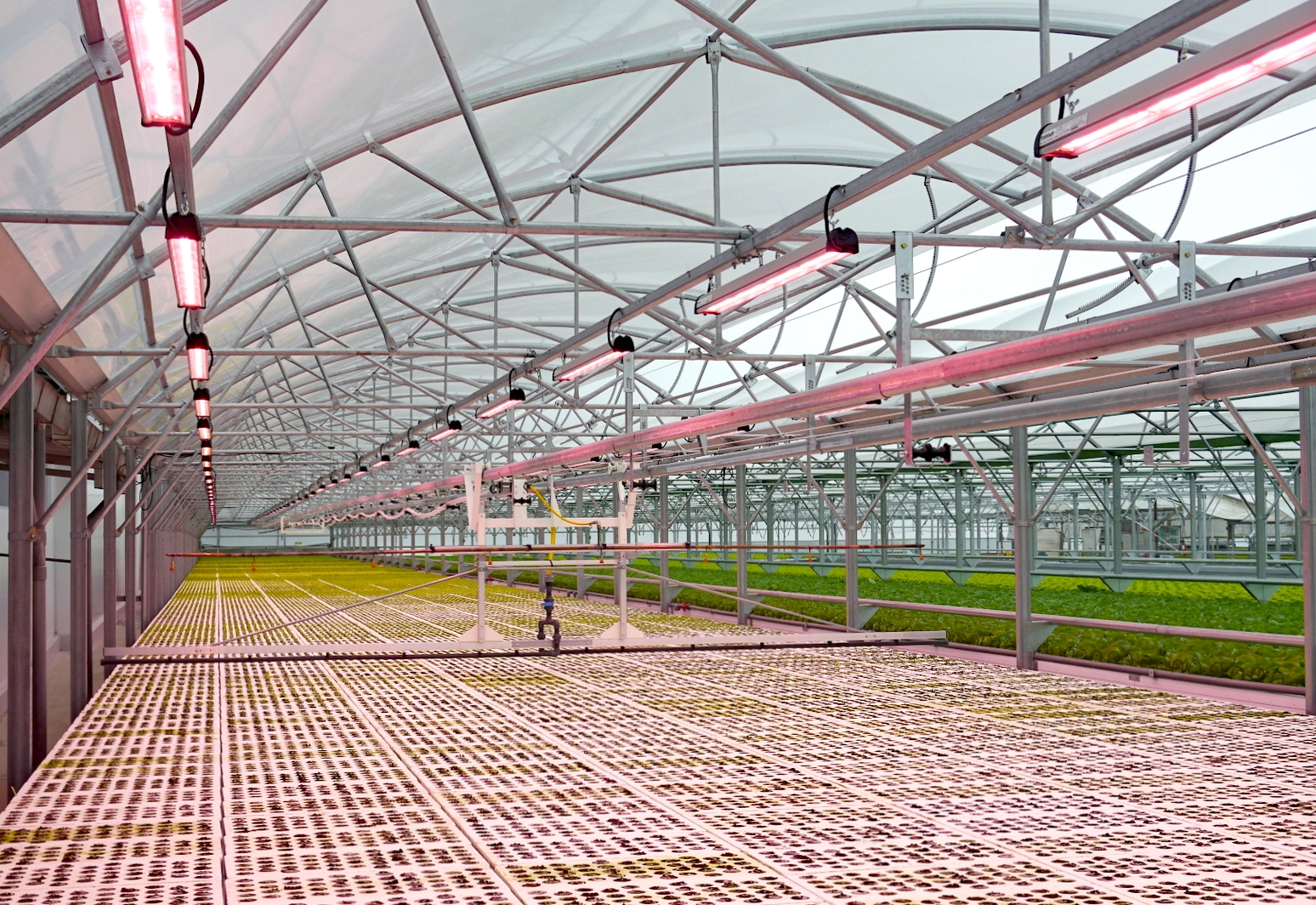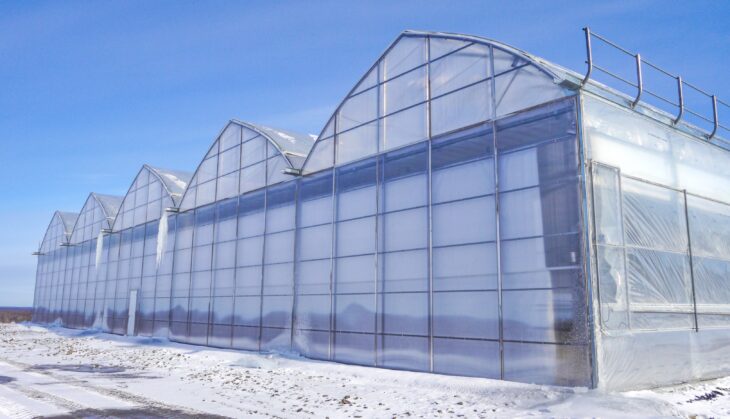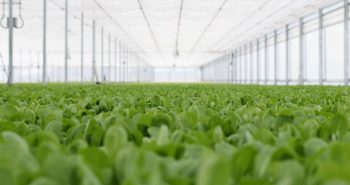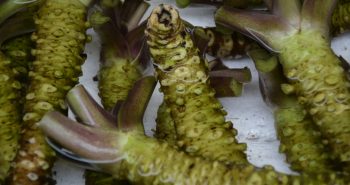This post is also available in: ![]() English
English ![]() Français (French)
Français (French)
Heat loss in greenhouses: a major concern for growers.
Efficient heat management in production greenhouses is a constant challenge for horticulturalists. Indeed, heating accounts for a significant proportion of operating costs, reaching upwards of 30% of total operating expenses over a year in certain northern regions, such as the North American snowbelt. Understanding heat loss mechanisms and ways of reducing them is essential to optimizing greenhouse crop profitability.
The main types of heat loss
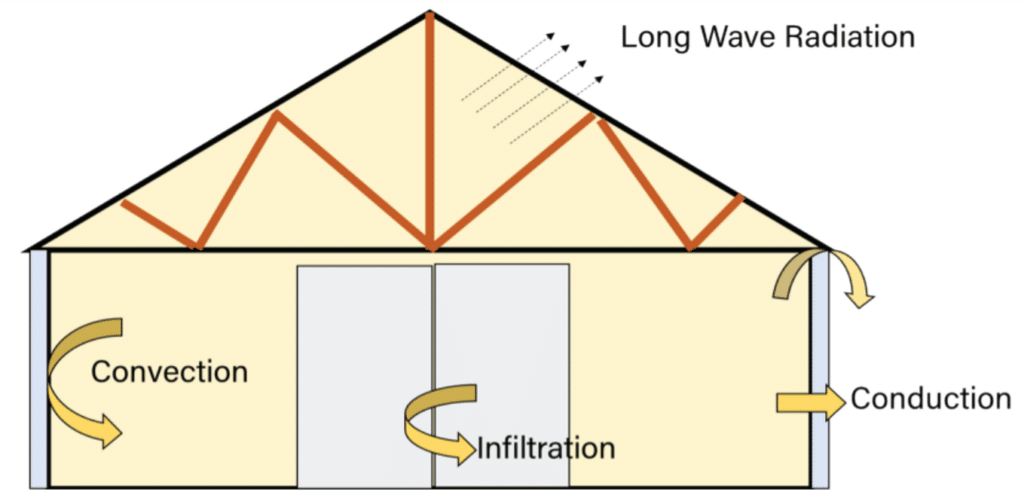
1. Conduction losses
Conduction is the main heat loss factor in a greenhouse. This phenomenon occurs when the warm air inside the greenhouse comes into contact with the cooler surface of the cover. Heat is then transferred through the material to the outside. The extent of this loss depends on the temperature difference between inside and outside, as well as the insulating properties of the covering material (more on this below).
2. Convection losses
Convection occurs when warm air escapes directly from the greenhouse, either through voluntary ventilation or involuntary leakage. This type of loss is particularly important during the ventilation periods needed to control humidity in the greenhouse.
3. Leakage losses
Infiltration losses are a crucial aspect of heat loss in greenhouses. This phenomenon occurs when cold air penetrates through openings or cracks, allowing warm air to escape. Studies show that these losses can account for up to 20% of total heat loss. Regular maintenance and careful sealing are, therefore, essential to optimizing the greenhouse’s energy efficiency.
4. Radiation losses
Although less mentioned in the sources provided, radiation losses also play a role. At night, the heat stored in the structure and plants is emitted as infrared radiation. If this radiation is not blocked by the greenhouse cover, it contributes to heat loss.the greenhouse cover does not block this radiation
The importance of choosing the right roofing materials
Overall heat transfer coefficient (U)
The choice of roofing material is crucial to limiting heat loss. Here’s a comparison of the main materials used, ranked from least to most insulating:
1. Single-glazed glass: Although offering excellent light transmission, single-glazed glass is the least efficient in thermal insulation. However, light transmission is very high.
2. Single-wall polyethylene: This solution is economical but not very insulating. It is more widespread in southern countries without cold periods. What’s more, single-wall polyethylene can relax more easily in windy conditions and can be damaged if it isless taut.
3. Double-walled polycarbonate (8 mm thick): This offers a good compromise between insulation and light transmission. However, it lets in slightly less light than double polyethylene and glass. One of the advantages of this solution is its cost and durability (10+ years).
4. Double glass: made up of two panels separated by a space of air or inert gas, it offers superior thermal insulation thanks to its structure, which effectively limits heat transfer between the inside and outside of the greenhouse. However, this solution is more expensive and requires a greenhouse structure with suitable extrusions (mouldings).
5. Double-wall inflated polyethylene: This solution creates an insulating layer of air between two plastic films, significantly improving thermal performance compared with single-wall polyethylene. Its high light penetration makes it one of the most popular covering materials in the world. Polyethylene with thermal properties inside the greenhouse can boost performance in terms of thermal retention (infra-red radiation).
6. Sandwich“ insulating panels (Kingspan type, 3.5” thick): These panels offer excellent thermal insulation, but at the expense of light transmission. In northern climates, these panels are mainly used to insulate the north sides and perimeter of greenhouses, and to insulate the foundations and lower parts (1.2m high maximum).
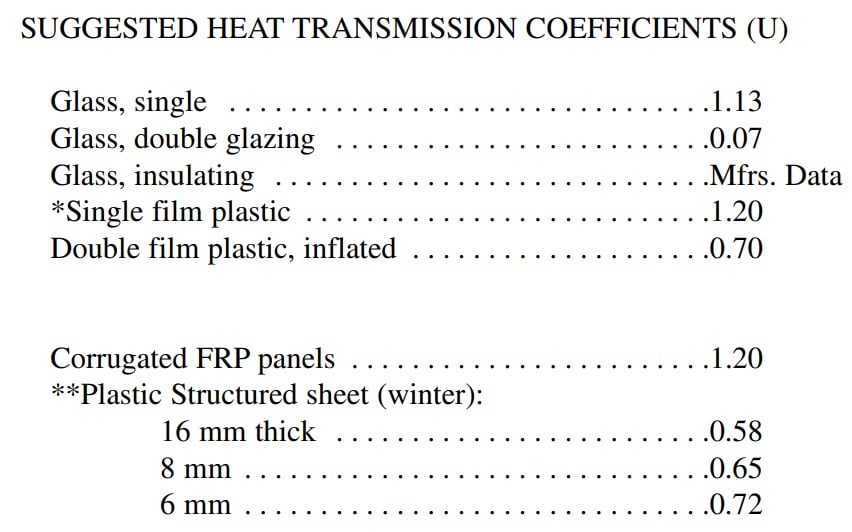
In the table above, the lower the heat transfer coefficient (U), the more suitable the covering material is for insulating the greenhouse during the cold season, thus reducing energy costs.
Single glass vs. double-thermal polyethylene greenhouse
A single glass greenhouse has a heat transfer coefficient of around 6.2 W/(m²-°C). In comparison, a heat-treated double polyethylene greenhouse has a coefficient of 2.8 W/(m²-°C) (Source: Joey Villeneuve, 2010).
To calculate the percentage difference, we can use the following formula:
Difference in % = (Initial value – Final value) / Initial value *100
i.e. (6.2-2.8)/6.2∗100 = 54.8
For example, a thermal-treated double (inflated) polyethylene greenhouse offers a thermal insulation improvement of around 54.8% compared with a single glass greenhouse. This significant difference explains why double polyethylene greenhouses are often preferred for greater energy efficiency, particularly in nordic regions where temperature control is crucial to cultivation.
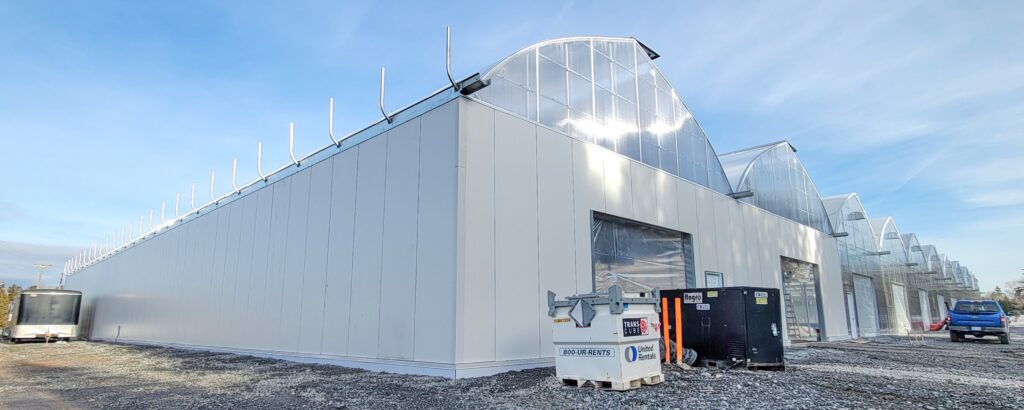
It’s important to note that the choice of material must consider not only its insulating properties, but also its ability to transmit the light needed by crops.
Strategies to reduce heat loss
In addition to the choice of roofing material, several strategies can be implemented to minimize heat loss:
1. Installation of thermal screens: These screens, deployed at night, create an additional barrier against heat loss. The choice of the fabric’s thermal quality is very important. There are many choices on the market today.
2. Insulating foundations and areas under crops: This measure reduces heat loss through the ground without affecting light levels.
3. Use of windbreaks: By reducing wind speed around the greenhouse, convection losses at the roof surface are limited.
4. Dehumidification: Dehumidifiers control humidity without excessive ventilation, thus reducing heat loss. This strategy is used in semi-enclosed greenhouses.
5. Smart ventilation management: by optimizing the opening of vents according to climatic conditions, you can maintain a balance between humidity control and heat conservation.
In conclusion, controlling heat loss in production greenhouses is a complex issue requiring a global approach. By combining a judicious choice of roofing materials with appropriate climate management strategies, growers can significantly reduce their energy costs while maintaining optimal conditions for their crops. The investment in insulation and climate control technologies may seem significant, but it often pays off in the long term, both economically and environmentally.
Sources:
Étude et analyse des effets d’une solution moussante sur le micro climat d’une serre, lorsqu’utilisée comme isolation et ombrage entre les matériaux de couvertures. Joey Villeneuve 2010 (lien).
Le défi de l’énergie dans les serres. Région Centre, France (lien).
Greenhouses: Heating, Cooling and Ventilation: University of Georgia extension (link)
National Greenhouse Manufacturers Association (NGMA). Heat loss document (link).
Temperature Control in Greenhouses (Purdue University). Krishna Nemali, PhD (link)
